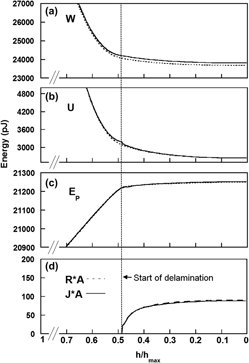Article contents
Characterization of the interfacial strength of SiNx/GaAs film/substrate systems using energy balance in nanoindentation
Published online by Cambridge University Press: 11 November 2013
Abstract

The linear elastic recovery measured from the nanoindentation unloading curve of a film/substrate system was used to determine the practical work for delamination using the proposed energy balance method and to estimate the delaminated area using the Hertz contact loaded model. The practical work for delamination was then calculated by dividing the external mechanical work required for generating interfacial crack by the delaminated area. The finite element model simulation demonstrated that the energy method was feasible and the estimation of delamination area using the Hertz model was accurate. The practical works for delamination in the plasma-enhanced chemical vapor deposition SiNx/GaAs film/substrate systems estimated using this method were in the range of 1–2.3 J/m2, which were in reasonably good agreement with those obtained from our another experimental approach.
- Type
- Articles
- Information
- Copyright
- Copyright © Materials Research Society 2013
References
REFERENCES
- 10
- Cited by




